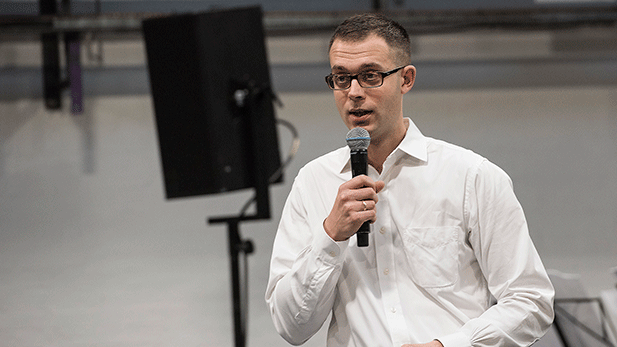Why stories matter - also in business

Photo: Jakob Boserup
“There he goes again with his stories,” is rarely how you would describe a colleague in a positive way - and certainly not your boss. But we all tell stories all the time. The things we say and how we say them is of great significance - also in a company, says two researchers.
- If I am telling you about the plot of a TV series, it is not as important what I am saying as the fact that we both belong to a group that is interested in exactly this TV series. We are establishing a bond, which is more important than the actual description of the series, says Anna Linda Musacchio Adorisio, Assistant Professor at the Department of International Business Communication.
This situation is an example of her research through the past 12 years; the role that stories or storytelling play in an organisation and what we do, when we tell stories. From an academic point of view, storytelling covers "the communicative practice that involves a storyteller and a listener."
When you are talking about your weekend in a Monday morning conversation, you are storytelling. When a bank reviews the past year in its financial statements, it is also storytelling. And it is the interaction between the official stories that companies tell and stories told by the employees that is the focus of Anna Linda Musacchio Adorisio's research.
Anna Linda Musacchio Adorisio (Photo: Niels Utoft Andersen)
Stories of the financial sector
Anna Linda Musacchio Adorisio has been working at CBS for almost two years. She is affiliated with Queen Mary University of London and has previously worked in USA, Switzerland and Sweden.
- My research evolves around storytelling in the financial sector. This sector has been through several upheavals for the past 30 years, and I have studied the stories that have been told by financial institutions and their employees. Take this example; Gordon Gekko from the movie Wall Street became an inspiration to a lot of people up through the 90s. He is the villain of the movie, but people were fascinated by him. His mantra "greed is good" was perceived in a much more positive way than originally intended, says Anna Linda Musacchio Adorisio. She continues:
- This is the power of storytelling. A story can live its own life in a way that is completely different from what the creators had in mind. Similarly, an organisation can spend a lot of time telling a story about responsibility; however, if it is not in tune with the story that is told about them internally as well as externally, the whole set-up may fall flat. It sounds simple, but an organisation is what it is. It takes a long time to change that.
Her contribution to storytelling research has been about underpinning the fact that storytelling takes place at several levels at the same time. Previous research used to focus on the cognitive level, which is about using storytelling to make sense of a situation. Anna Linda Musacchio Adorisio's research is pointing towards storytelling having a social and an emotional level.
- Stories have a strong social element. When we share knowledge about a situation, we also establish a sense of community with others. Also, stories have the ability to evoke feelings with the audience. Even when we try to hide our thoughts and feelings about a situation, they shine through in the way we tell the story.
Anna Linda Musacchio Adorisio has conducted research within the area for more than 12 years and is now working on three different research projects. Her research includes a study of the contribution of storytelling in relation to creating and maintaining a responsible business culture.
Anders Kryger (Photo: Preben Nielsen, E-frame)
The story of a strategy
The creation and communication of a new strategy is an example of a situation where storytelling is a central element. Anders Kryger is doing his industrial PhD about exactly this exercise in collaboration with the Department of International Business Communication and the engine company MAN Diesel & Turbo.
- Since 2007, I have been working with communication in MAN Diesel & Turbo. My experience is that communicating about a new strategy can be difficult. Therefore I am studying how strategy can become a living, breathing story - how do you turn a strategy document into something that will live in the organisation?
To answer this question, Anders Kryger is conducting a large number of interviews with employees at MAN. Through interview techniques from storytelling, he is looking into how the strategy comes alive to the staff. He has been working on the project since February 2015, and it is running until the summer of 2018. So he still has a lot of PhD work ahead of him. He is however starting to think that storytelling methodology may be part of the solution to communicating strategy effectively.
- The trick in using storytelling from a management point of view is that it is an easy way to simplify something that is complex or diffuse. Many organisations have a tendency to talk about problems and solutions at a superficial level, so it is hard to put into practice for an employee, says Anders Kryger.
A special technique
In his work, Anders Kryger is using a special interviewing technique based on narrative therapy, which makes it possible to process a problem from many perspectives. The idea is to make this interviewing technique applicable to organisations as an instrument to explain a strategy to employees.
- You base your story on a specific event, which may illustrate either something problematic in the current situation or something desirable in a possible future. The manager describes an event or asks the participants to do it and then reflect on the story at several levels, says Anders Kryger.
The five levels go from describing an experienced event and charting the impact of the event - to the people that are present and the entire company - to evaluating the impact and substantiating what the impact says about the leader, the employees and the organisation.
- The aim is to get as many reflections as possible out of this process in a methodical way. Why do we think that a situation was handled inappropriately? And what is important to us in the future? These questions concretise how a new strategy separates from the old and how you can mobilise employees. At least that is my hope and the aim of my project, says Anders Kryger.
Both researchers will talk about their work and perspective at the event "Communicating through storytelling - the power of using stories in organizations" organised by CBS Alumni and the Department of International Business Communication.The event takes place on 2 March 2016.
Read more about the researchers; Anna Linda Musacchio Adorisio and Anders Kryger
Relevant articles
Do you dare to let your employees communicate?